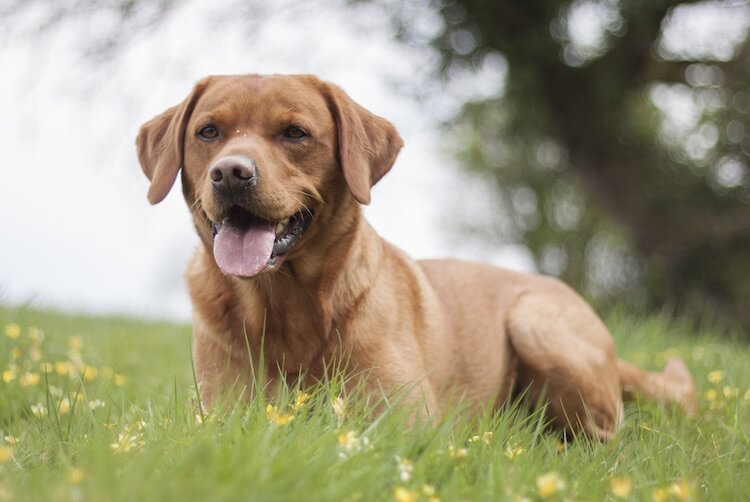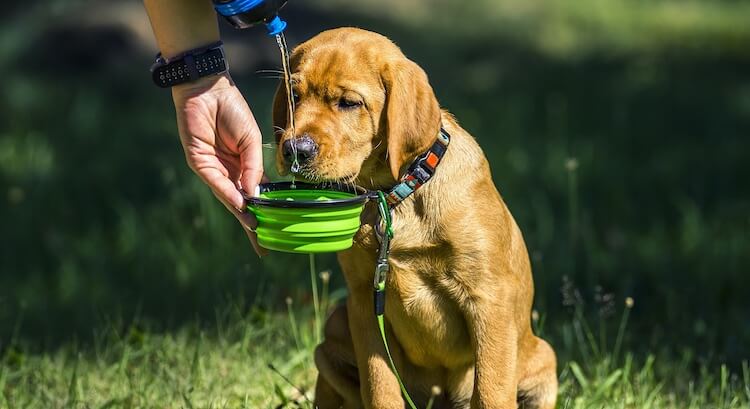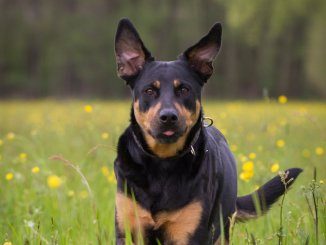In a world where Labrador Retrievers are loved for their classic blacks, chocolates, and yellows, the Red Fox Lab bursts onto the scene with a coat as fiery as an autumn blaze. This isn’t just another color variation; it’s a showstopper, turning heads and captivating hearts with its unique, russet beauty.
Imagine a dog that combines the Labrador’s cherished qualities – loyalty, intelligence, and a friendly demeanor – with an extraordinary twist. The Red Fox Lab is a living tapestry of vibrant reds and deep, burnished oranges, reminiscent of a fox yet undeniably Labrador in spirit and temperament. Their coat color is a rare spectacle, a splash of wildness, bringing an exotic flair to the familiar, comforting presence of a Labrador.
But the allure of the Red Fox Lab goes beyond their striking appearance. These dogs are a whirlwind of joy, matching your every mood with an infectious enthusiasm. They are the embodiment of the phrase, “a loyal friend in vibrant colors.”
As you embark on the journey of discovering the Red Fox Lab, prepare to be swept away by their charm, their boundless energy, and the unique vibrancy they bring to the traditional Labrador palette.
TABLE OF CONTENTS
- Red Fox Lab Quick Breed Summary
- Origin of the Red Fox Labrador Retriever
- Physical Appearance of the Red Fox Lab
- Temperament and Behavior of the Red Fox Lab
- Care Guide for Red Fox Labs
- How to Train a Red Fox Lab
- Known Health Issues in Red Fox Labs
- FAQs on Red Fox Labrador Retrievers
- So, Is the Red Fox Lab Right for You?
Red Fox Lab Quick Breed Summary
Origin of the Red Fox Labrador Retriever
From Adobe Stock
The Red Fox Lab is not a separate breed but rather a striking color variation within the Labrador Retriever family. This variation is akin to finding a rare, beautifully colored leaf among a sea of green ones. It’s still part of the same tree, yet it stands out with its unique charm. This color distinction has sparked both curiosity and admiration among dog lovers and experts alike.
These dogs share the same lineage with the conventional Labradors, tracing their roots back to Newfoundland where they were bred for their adeptness in retrieving fishing nets and waterfowl. The traditional Labrador colors – black, chocolate, and yellow – have long been recognized and cherished, but the Red Fox Lab, a rare but natural occurrence within the breed, is a testament to the genetic diversity inherent in these beloved dogs.
Unraveling the Mystery: Why the Red Hue?
The unique red hue of the Fox Red Labrador Retriever is a marvel of genetics. This striking color results from the same genetic factors that produce the yellow Labrador, but with a twist. The intensity of the yellow pigment in their coat is heightened, resulting in the deep, fox-like red shade that gives these dogs their name. It’s a perfect example of how slight variations in genetics can lead to such visually distinct outcomes.
Kennel Club Recognition
The Red Fox Labrador is not recognized as a separate breed by major kennel clubs. Instead, it is categorized under the standard Labrador Retriever breed.
Major kennel clubs like the American Kennel Club (AKC), the United Kennel Club (UKC), and The Kennel Club in the UK recognize the Labrador Retriever in three primary colors: black, yellow, and chocolate. The Red Fox Labrador falls under the “yellow” category.
Physical Appearance of the Red Fox Lab
From Adobe Stock
The Red Fox Lab is a canine masterpiece, where physical strength meets grace in a stunning red package. Let’s explore the defining physical traits that set these dogs apart in the world of Labradors.
Stature and Build
At first glance, the Red Fox Lab strikes you with its muscular, robust build. Characterized by a broad skull, large head, and strong jaw, these dogs epitomize strength. Yet, their kind, expressive eyes and floppy ears hanging beside their head soften their powerful aura, revealing the friendly soul beneath. Standing as a medium to large breed, their level back and solid structure speak to their inherent athleticism and agility.
Unique Features: Tail and Coat
The Red Fox Lab is renowned for its ‘otter’ tail – thick, powerful, and tapering. This tail is more than an aesthetic feature; it serves as a functional rudder, aiding them in water, a testament to their swimming prowess. Accompanying this is their webbed feet, another nod to their aquatic abilities. Observing a Red Fox Lab in the water, effortlessly gliding and turning, is to witness them in their element.
Their coat, a rich, deep red, sets them apart. This ‘fox-red’ hue is technically a dark shade of yellow, as per breed standards. You might occasionally notice white spots, especially around the chest, adding to their distinctive appearance. Their coat, thick and dense yet short, embodies the perfect balance of practicality and aesthetic appeal.
Height and Weight
In terms of physical dimensions, Red Fox Labs are impressively sized. Females typically weigh between 55-70 pounds, with males being slightly heavier, ranging from 65-80 pounds. Height-wise, males usually stand between 22.5-24.5 inches at the withers, while females measure slightly smaller, between 21.5-23.5 inches. This size contributes to their commanding presence, yet it’s balanced with a demeanor that’s as warm as their coat color.
Temperament and Behavior of the Red Fox Lab
From Adobe Stock
The Red Fox Labrador Retriever, despite its unique coat color, shares the same endearing personality traits that define the Labrador breed. These dogs embody the essence of Labradors: friendly, sociable, and eager to please.
In my interactions with Red Fox Labs, I’ve consistently observed their gentle disposition and unwavering loyalty. They thrive on human interaction and are equally affectionate with family members and strangers alike. A well-suited breed for families, where their ability to bond with everyone adds to the joy of the household.
Intelligence and Playfulness: The Hallmarks of a Labrador
When it comes to intelligence and a playful spirit, the Red Fox Lab is indistinguishable from other Labradors. Their quick learning ability and eagerness to engage in activities make them excellent companions for various roles, from hunting to service.
I’ve seen firsthand how their playful nature can turn a routine training session into a fun and engaging experience. This combination of intelligence and playfulness not only makes them versatile in their capabilities but also ensures that they are a delightful presence in any home.
The Gentle Hunter: Balancing Instincts with Sociability
Reflecting their lineage as waterdogs, Red Fox Labs exhibit the same moderate hunting drive and love for water as their Labrador counterparts. They possess the ‘soft mouth’ characteristic, a testament to their controlled and gentle nature, even when engaging in hunting activities.
In my experience, these dogs exhibit a high prey drive, but it’s often channeled into playful activities that are suitable for family settings. Their non-aggressive demeanor towards other animals and their ability to adapt their natural instincts into play highlights the balanced and amiable nature inherent in the Labrador breed.
Communication and Temperament: The Red Fox Lab’s Balanced Approach
The Red Fox Lab’s vocalization patterns align closely with what is expected of a typical Labrador. They are not excessively vocal, tending to bark out of excitement or to alert their family, rather than from aggression or oversensitivity. This moderate approach to barking, combined with their friendly and non-aggressive nature, underscores their suitability for various living situations.
With appropriate training, any inclination towards unnecessary barking can be effectively managed, making them a well-rounded companion for both active families and individuals alike.
Care Guide for Red Fox Labs
From Adobe Stock
Caring for a Red Fox Lab is an incredibly rewarding experience, full of active days and affectionate moments. Just like any Labrador, specific needs must be met to ensure they live a happy, healthy life.
Feeding Guidelines
Feeding a Red Fox Lab is all about balance and quality. These energetic dogs require a diet that fuels their active lifestyle but also keeps their weight in check. I recommend a high-quality dog food that’s rich in protein and has the right balance of essential nutrients.
Portion control is crucial – too little and they won’t have the energy they need; too much, and they risk becoming overweight, which is a common issue in Labradors.
The frequency and size of meals depend on age, size, and activity level. Puppies, for instance, need small, frequent meals, while adults do well with two meals a day. And let’s not forget treats – they’re great for training, but moderation is key! I’ve seen many Red Fox Labs turn a little too round due to over-treating, so keep an eye on those extra snacks.
Exercise Requirements
Exercise is paramount for a Red Fox Lab. These dogs are bundles of energy and require regular physical activity to keep them fit and mentally stimulated. I always advise at least an hour of exercise daily, which can include walks, runs, swimming, and fetch games. Their love for water makes swimming an excellent exercise and a fun way to cool down in the summer.
Mental stimulation is just as important. Interactive games, training sessions, and puzzle toys help keep their minds sharp. Remember, a tired Red Fox Lab is a happy Red Fox Lab. Regular exercise helps prevent behavioral issues and keeps them at a healthy weight.
Grooming Needs
The gorgeous red coat of a Red Fox Lab is surprisingly low maintenance. Regular brushing, about once a week, is usually enough to keep their coat healthy and reduce shedding. During shedding seasons, you might need to brush them more frequently to manage the extra fur.
Bathing should be done as needed – too frequent bathing can strip their coat of natural oils. Also, don’t forget about ear care, nail trimming, and dental hygiene, which are crucial for their overall health. I find that making grooming a positive experience, filled with praise and treats, turns it into a bonding activity rather than a chore.
How to Train a Red Fox Lab
From Adobe Stock
Training a Fox Red Labrador Retriever is not just about teaching them commands; it’s about building a bond and understanding the unique personality behind that stunning red coat. Just like any Labrador, these dogs are eager learners and thrive on positive reinforcement.
Starting with the Basics
The first step in training your Red Fox Lab is to establish a foundation of basic commands like sit, stay, come, and heel. What’s incredible about these dogs is their eagerness to please, which makes them responsive and quick learners. I’ve found that using treats, praise, and play as rewards works wonders. It’s important to keep training sessions short, especially for puppies, as their attention spans can be limited. Consistency is key – practice regularly and be patient. Remember, every dog learns at their own pace.
Socialization and Behavioral Training
Socialization is crucial for a well-rounded Red Fox Lab. Expose them to different people, pets, and environments from a young age. This exposure helps them become confident and well-adjusted adults. In my years of working with Labs, I’ve noticed that socialized dogs are less likely to develop fear-based behaviors and are more outgoing.
Behavioral training is also essential. Address behaviors like jumping, barking, or chewing right from the start. Positive reinforcement is the way to go – reward the behavior you want to see and redirect undesirable actions. For instance, if your Lab jumps to greet, teach them to sit for attention instead. Be firm but gentle, and they’ll catch on quickly.
Advanced Training and Mental Stimulation
Once your Red Fox Lab masters the basics, you can move on to more advanced training. This could include agility training, scent work, or even therapy dog training. These activities provide mental stimulation and strengthen the bond between you and your dog. Labs, with their intelligence and versatility, excel in these areas.
Known Health Issues in Red Fox Labs
Red Fox Labs, like any breed, are susceptible to certain health issues. Understanding and recognizing these conditions is essential for providing the best possible care. Here’s an in-depth look at some common health concerns they face, including their causes, symptoms, and management tips.
Hip and Elbow Dysplasia
These are hereditary conditions common in larger breeds like the Fox Red Labrador Retriever. These conditions occur when the joints develop improperly, which can lead to arthritis and mobility issues. Symptoms include limping, difficulty rising, and reluctance to jump or run. Genetics, rapid weight gain, and improper exercise can contribute to these conditions.
- Maintain a healthy weight to reduce joint stress.
- Engage in regular, low-impact exercise like swimming.
- Consider supplements like glucosamine and chondroitin.
- Regular vet check-ups for early detection and management.
Progressive Retinal Atrophy (PRA)
- Regular eye exams for early detection.
- Genetic testing can identify predisposed dogs.
Obesity
Obesity is a significant health concern for Red Fox Labs, particularly due to their love for food. Excess weight can lead to diabetes, joint issues, and heart disease. Causes include overfeeding, lack of exercise, and genetics.
- Proper portion control and a balanced diet.
- Regular exercise.
- Avoiding too many treats.
- Regular weigh-ins and health checks.
Ear Infections
Red Fox Labs are prone to ear infections, often due to their floppy ears, which can trap moisture and debris. Symptoms include ear odor, redness, and scratching.
- Regular ear cleaning with a vet-approved solution.
- Drying ears thoroughly after swimming or bathing.
- Watching for signs of infection (odor, redness, scratching).
- Prompt veterinary attention if an infection is suspected.
FAQs on Red Fox Labrador Retrievers
What is the lifespan of a Red Fox Labrador Retriever?
Red Fox Labrador Retrievers typically have a lifespan of about 10 to 12 years. This can vary based on factors like genetics, health, diet, and lifestyle. Regular veterinary care, a balanced diet, and adequate exercise are crucial in promoting a long, healthy life for these dogs.
Are Red Fox Labs suitable as family dogs?
Absolutely! Red Fox Labs are known for their friendly and affectionate nature, making them excellent family dogs. They are gentle, loyal, and great with children. Their sociable demeanor means they generally get along well with other pets too. Regular socialization and training enhance their innate family-friendly traits.
Are Red Fox Labs easy to train?
Red Fox Labs are highly trainable, thanks to their intelligence and eagerness to please. They respond well to positive reinforcement methods like treats, praise, and play. Consistency and patience are key in training. They excel in obedience, and agility, and can be trained for specific roles like therapy or service work.
How much does a Red Fox Lab cost?
The cost of a Red Fox Lab can vary widely depending on factors like the breeder’s reputation, location, and the dog’s lineage. Generally, you can expect to pay anywhere from $800 to $2,000 for a Red Fox Lab puppy. It’s important to purchase from a reputable breeder who conducts health screenings and provides a good environment for the puppies.
Are Red Fox Labs good with other animals?
Yes, Red Fox Labs generally get along well with other animals, especially when socialized from a young age. Their friendly nature extends to both humans and other pets. However, like all dogs, individual temperaments can vary, so it’s always wise to supervise initial interactions with other animals.
So, Is the Red Fox Lab Right for You?
Choosing the right dog is a decision that resonates through every hike, snuggle, and fetch game. With their unique combination of vibrant energy, intelligence, and affection, Red Fox Labs can make wonderful companions, but they are not the perfect fit for every lifestyle.
Who Is the Red Fox Lab For
- Active Individuals or Families: They thrive with those who love outdoor activities such as hiking, running, or swimming. Their energy and playfulness make them great adventure companions.
- Families with Children: Known for their patience and gentleness, Red Fox Labs are fantastic with kids, fitting seamlessly into family life.
- Training Enthusiasts: Their intelligence and eagerness to learn make them a joy to train, ideal for those who enjoy engaging their pets in learning activities.
- Experienced Dog Owners: Best suited for those familiar with active breeds and capable of managing and channeling their energy.
- People with Spacious Homes: They do best in environments where they can move freely, ideally with access to a yard.
Who Isn’t Red Fox Lab For
A Red Fox Lab might not be the best choice for:
- First-Time Dog Owners: Their high energy levels and training needs can be overwhelming for those new to dog ownership.
- Sedentary Lifestyle Individuals: If your lifestyle is more relaxed and lacks the capacity for daily vigorous exercise, a Red Fox Lab may be too high-energy for your environment.
- Apartment Dwellers: While they can adapt, they generally flourish in homes with more space.
- Allergy Sufferers: Their shedding can be problematic for those with allergies.
- Busy Schedules: If you can’t commit to regular exercise and engagement, a Red Fox Lab might not be suitable due to their need for consistent activity and attention.
Could they be your companion too? Let us know below!










I’m thinking of taking on a 6 year old female fox lab im worried about the life span as getting a pup i may only get 4 years or less with a 6 year old and how old could I hunt with her as she has been hunted all her life any input would be greatly appreciated